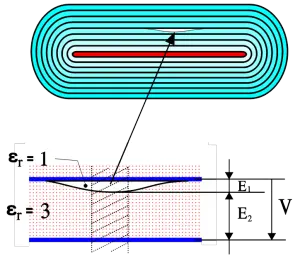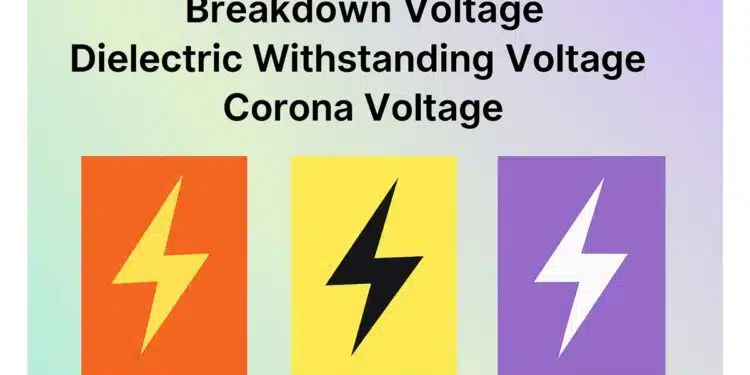This article explains some basic parameters of capacitors – breakdown voltage / dielectric withstanding voltage and corona voltage.
Key Takeaways
- The article explains basic parameters of Breakdown Voltage, including dielectric withstanding voltage and corona voltage.
- Dielectric strength is determined by breakdown voltage, measured under controlled conditions like temperature and voltage curve shape.
- There are two capacitor breakdown types: electrical breakdown and thermal breakdown, each with critical specifications.
- Electrical breakdown tests vary and include static, dynamic, and self-healing suppressed dynamic methods.
- Corona voltage is crucial for high-voltage capacitors and indicates the point where electrical discharges in gases begin, affecting dielectric performance.
Dielectric Withstanding / Breakdown Voltage
The dielectric strength of the material is determined by the breakdown voltage and is expressed in kV/cm. As time, temperature and other factors determine the breakdown voltage this is reflected in conditions for measurements of the dielectric withstanding voltage, DWV. They are performed at a specified temperature, material thickness, frequency and shape of test voltage curve as well as connection method. DWV usually is determined as an average value of set of samples due to the effects of material variations etc.
Capacitor Breakdown Types
There are two basic types of capacitor breakdowns:
(I) Electrical breakdown
During electrical breakdown, electrical field, usually related to excessive voltage applied, exceeds the electrical strength of the dielectric material resulting in complete disruption and low resistance / short circuit failure mode. The responsible conductivity mechanism is mostly tunneling of electrons or holes accelerated by electrical field over the critical value. An avalanche effect may then lead to a complete destruction and catastrophic failure – short circuit of the capacitor.
Critical specification parameters are: Rated AC/DC Voltage, Category Voltage (maximum voltage at defined temperature).
(II) Thermal breakdown
During thermal breakdown electrical field is lower then a critical value (applied voltage lower then rated voltage), but excessive current is flowing through the capacitor – either as high ripple current, transient current or in reverse mode (polarized capacitors). Joule heating caused by passing current increase local temperature inside of the capacitor structure up to a thermal damage and disruption of its materials.
Critical specification parameters are: Maximum ripple current/voltage; Maximum power rating; Maximum dV/dt or dI/dt transient or minimum series resistance of the circuit.
Electrical Breakdown Test
Capacitor electrical breakdown value may not be such exact parameter as one could expect. The critical parameter is applied electrical field on the dielectric but apart of the ambient temperature the state of the dielectric / energy dissipation may also depend on time and history (inner temperature due to past events, moisture etc).
for electrical breakdown we can consider the following test procedures that in some capacitor technologies may give different breakdown voltage values:
1] Static Breakdown
On external power supply we set-up maximum of current limitation and then increase voltage from rated voltage by small increments to minimize transient current until breakdown occurs. This can be done manually but, of course, it is better to do by more sophisticated programmable power supply or even automatic breakdown measurement systems that preciously detect the BDV voltage by change of dI/dt.
2] Dynamic Breakdown

During dynamic breakdown high power pulse is applied to the capacitor through low series resistance. Caution: the circuit has to reflect the maximum transient voltage/current limitation conditions not to cause thermal breakdown.
The test sequence is usually automated that we apply certain amount of pulses at desired voltage (such as 1.1xVr) and then if the capacitor survives we move to one step higher voltage ( for example 1.2xVr) until the breakdown of the capacitor. … again this can be fully automated using programmable power supplies.
3] Self-healing Suppressed Dynamic Breakdown
This test is identical to the dynamic breakdown as above, just the change is that we will replace the samples after each voltage step. This is relevant for capacitor technologies with self-healing as we want to suppress capacitors’ ruggedisation by self-healing process in previous load step. Target is to get the impression about its BDV robustness when uneven spike happens in real operation (without any conditioning by ageing) .
Differences between the BDV induced by above methods depend to the capacitor technology. There would be practically no difference on air/vacuum capacitors, little on electrostatic capacitors and more remarkable on electrolytic capacitors with self-healing where obviously the Static BDV > Dynamic BDV > Dynamic Breakdown without history
Corona Voltage
A practical and important limit for the breakdown voltage on high voltage capacitors such as film capacitors is the corona voltage, i.e. that voltage where corona starts appearing. Corona is initial electrical discharges in gases which then are ionized. The ionized products in air or in carbon-rich environments, typical in all microcavities or voids in the dielectrics as well as in large cavities within the component package, consist of ozone and nitrous fumes. Most organic dielectrics are directly affected by degradation. If the gaseous products have been created within a hermetically-sealed package as their concentration
increases they will degrade the behavior of organic dielectrics. Remember that AC peak voltages just above the corona voltage every half-cycle give a new contribution to the corona products. Additionally there is a heat release from the corona phenomenon which further accelerates the chemical decomposition.
On the whole there is a certain smallest field strength
needed in the cavity in order to start ionization. Moreover the ionization gap length comes into play. But even if the field strength should be considerably higher in one part of a mixed dielectric AC voltages below 250 V R.M.S. are harmless also in the most unfavorable case. On one condition: No incoming transients should be allowed that otherwise might start an ionization course of events. Hence we ought to create safe margins based on our knowledge of occurring transients. If unsure, one should use capacitors where the voltage is distributed over elements connected in series.
Transients and anomalies in the dielectric are a dangerous combination.

The following example will demonstrate the danger. For the sake of simplicity the measurements and dielectric constants are chosen as in Figure 1. From general formula we obtain εr1 x E1 = εr2 x E2; 1 x E1 = 3 x E2; E1 = 3E2. Here we unintentionally have got an electric field strength 3 times the rated one. ”Safe” rated AC voltages just below 250 V or incoming transients certainly will start corona in such a void.
In high voltage ceramic capacitors intended for high reliability systems a testing and screening technique is used to detect voids and delaminations by evoking partial discharges (corona). The method uses preferentially AC voltages just above the corona inception voltage (CIV) and is able to detect voids exceeding EIA-469 size requirements.
Test voltage
The test voltage is a practical guarantee value of the capacitor. It is positioned well below the corona voltage and is applied for a specific limited time, e.g. 2 seconds at production control and 1 minute at type tests and incoming inspection. Common test voltages may be 1.5 x VR, 2 x VR and the like.
FAQ: Breakdown Voltage, Withstanding Voltage and Corona Voltage
Dielectric withstanding voltage (DWV) is the maximum voltage a capacitor’s dielectric can endure without failure. It is measured under controlled conditions of temperature, material thickness, frequency, and test voltage shape. DWV is usually expressed in kV/cm and averaged across multiple samples.
There are two main types: Electrical breakdown, caused by excessive electric field leading to tunneling and short-circuit failure, and Thermal breakdown, caused by excessive current (ripple, transient, or reverse mode) leading to overheating and material damage.
Three methods are used: Static Breakdown (gradual voltage increase until failure), Dynamic Breakdown (high-power pulses applied stepwise), and Self-healing Suppressed Dynamic Breakdown (samples replaced after each step to avoid conditioning effects).
Corona voltage is the threshold where partial discharges begin in voids or microcavities of the dielectric. It produces ozone and nitrous fumes, which degrade organic dielectrics and accelerate capacitor aging. Safe design margins are required to avoid corona inception.
Pulse Test voltage is a practical guarantee value, applied below corona voltage for a limited time (e.g., 2 seconds in production or 1 minute in type tests). Common values are 1.5×VR or 2×VR, ensuring capacitor reliability under normal conditions.
How-to: Test Capacitor Breakdown and Withstanding Voltage
- Prepare the test setup
Use a programmable power supply with current limitation. Ensure the capacitor is connected under controlled temperature and frequency conditions.
- Perform static breakdown test
Increase voltage gradually from the rated value in small increments until breakdown occurs. Record the breakdown voltage (BDV).
- Perform dynamic breakdown test
Apply high-power pulses at incremental voltage levels (e.g., 1.1×VR, 1.2×VR) until failure. Ensure the circuit respects transient current limits to avoid thermal breakdown.
- Conduct self-healing suppressed test
Replace the capacitor sample after each voltage step to prevent conditioning by self-healing. This method evaluates robustness against uneven spikes in real operation.
- Verify corona inception voltage (CIV)
Apply AC voltages slightly above the corona voltage to detect voids or delaminations. Ensure safe margins to prevent partial discharges in operation.
- Apply test voltage for quality assurance
Use a controlled test voltage (e.g., 1.5×VR for 2 seconds) to confirm capacitor reliability during production and inspection.






























